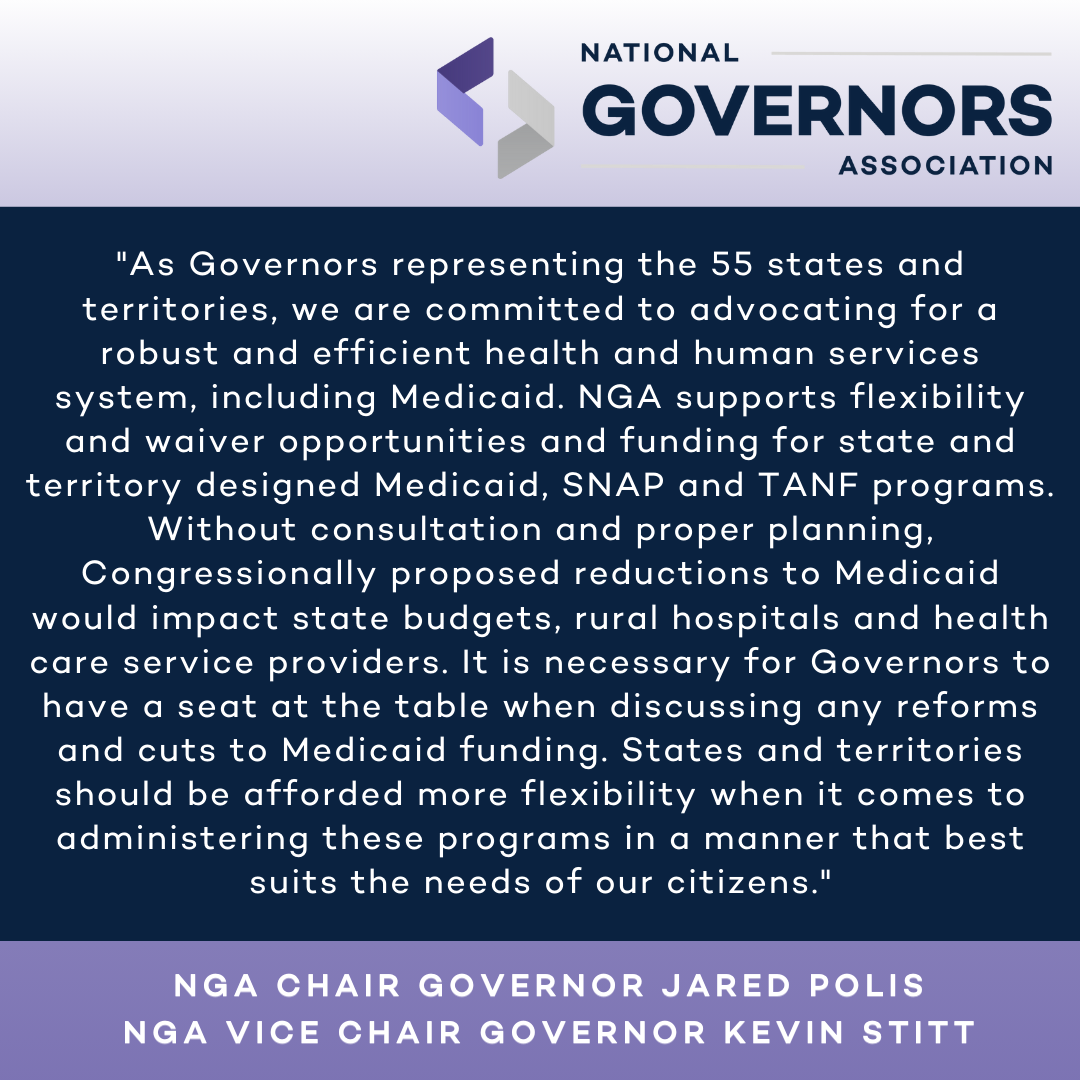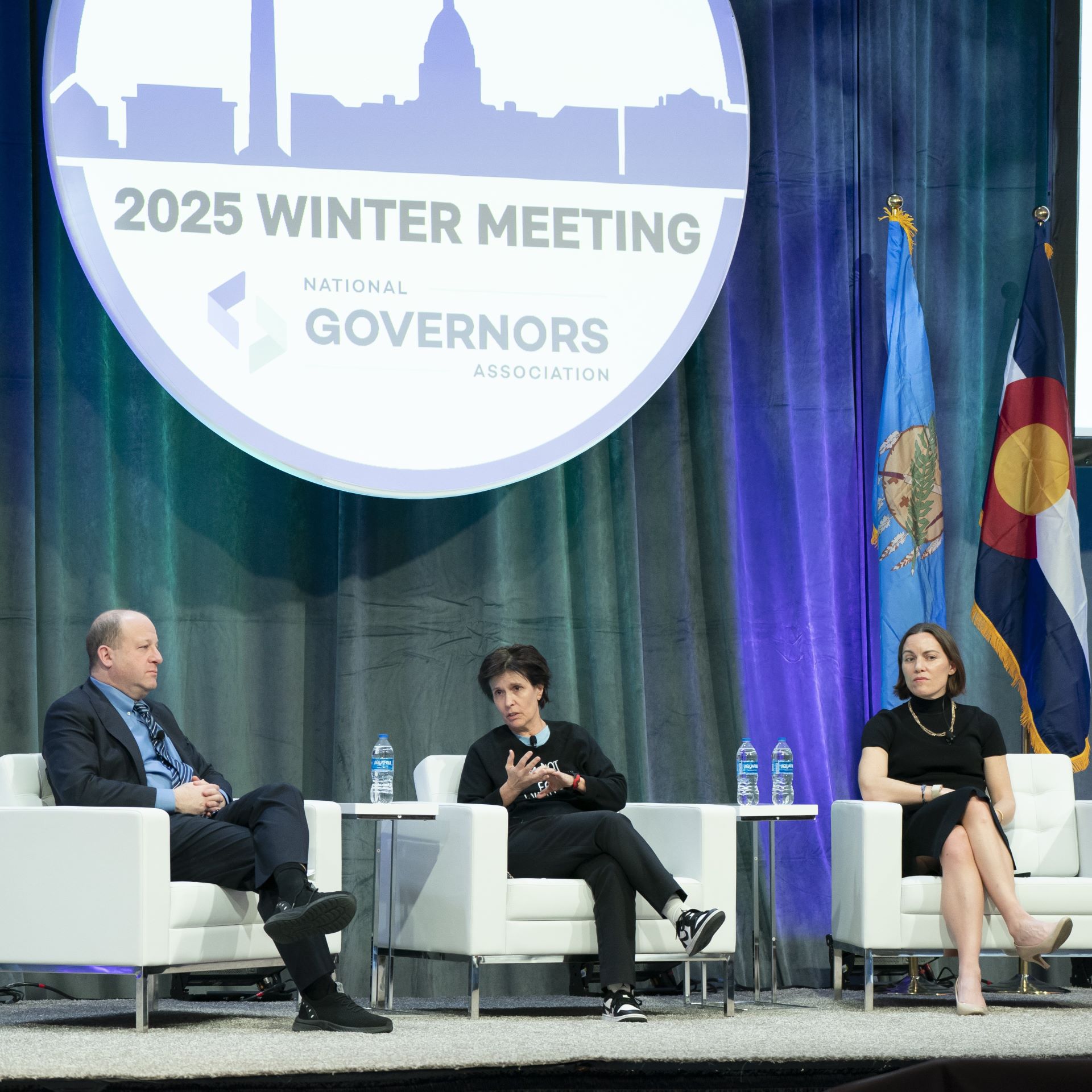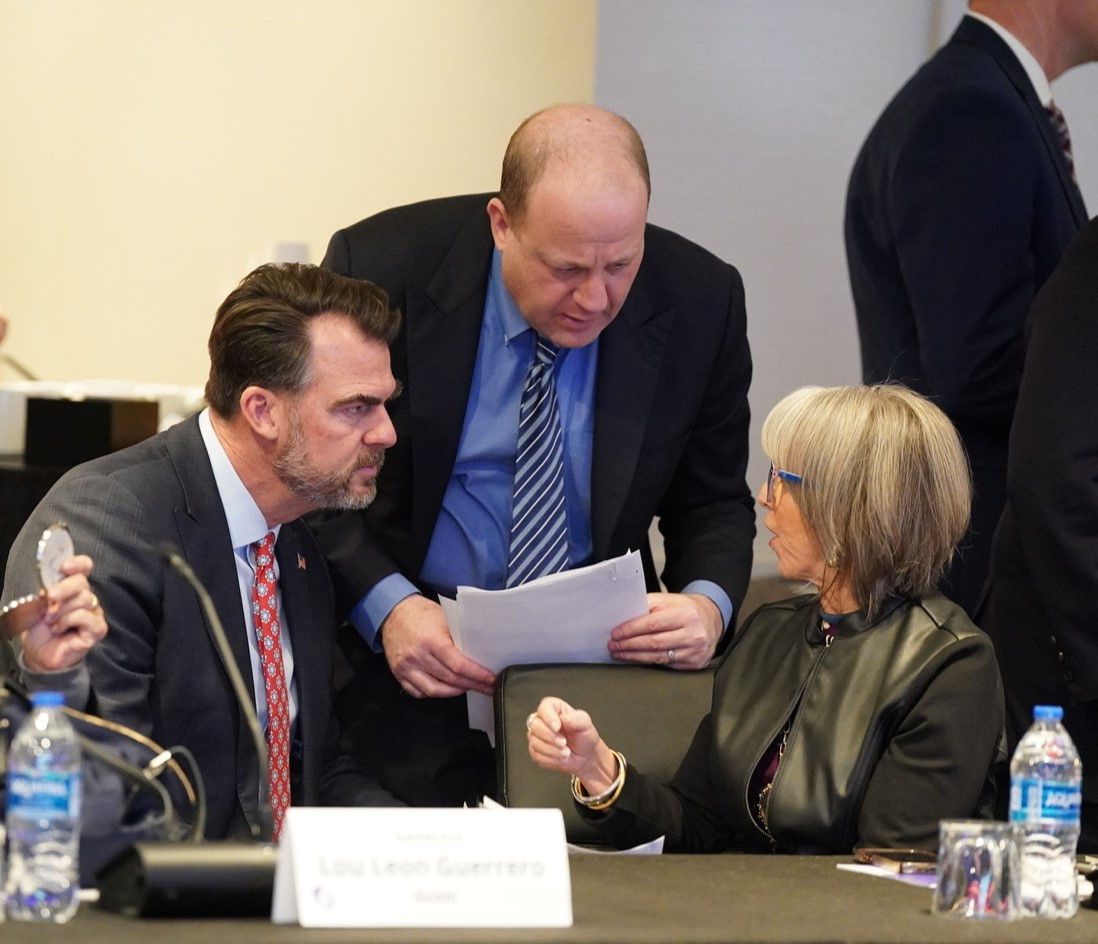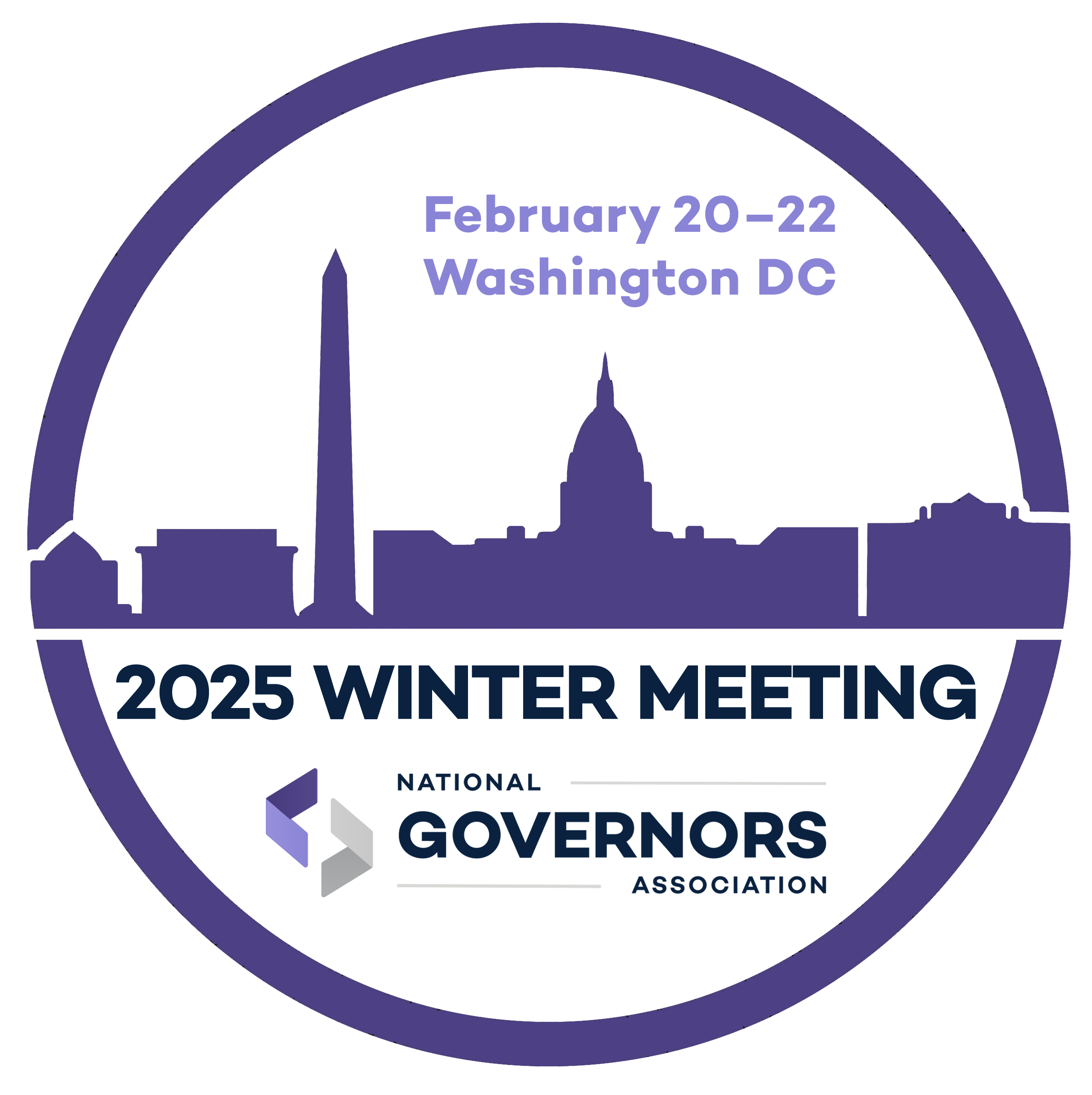This memo, originally published on April 3, and was last updated on July 13.
Introduction
As governors consider ways to mitigate the spread of COVID-19 and protect high-risk communities, such as older adults and the health care workers and other providers who serve them, targeted approaches for post-acute and long-term care (LTC) facilities such as nursing homes and assisted living as well as in-home and community settings are critical.
This resource provides key considerations for governors and state leaders as they develop strategies to protect the health and well-being of individuals receiving LTC. It includes: (1) a high-level review of considerations for governors; (2) a detailed briefing of considerations and related state examples; and (3) an appendix with quick links to additional resources, including relevant federal guidance.
To accompany this memo, NGA has developed a table of state actions specific to LTC facilities, which have garnered significant attention due to elevated risk of COVID-19 outbreaks and deaths, as well as a briefing focused on testing in LTC facilities. Additionally, NGA released a separate memo that offers additional considerations for individuals with access and functional needs, including people with disabilities.
Considerations for Governors
(i) Consider executive action to prioritize older adults and others receiving LTC, as well as their providers and caregivers, as a critical part of the state’s COVID-19 response and provide clear direction for these populations as part of reopening plans
(ii) Dedicate teams, personal protective equipment (PPE), funding, and other resources to support LTC facilities and home and community-based services (HCBS) providers, with a focus on preventing and addressing outbreaks in facilities
(iii) Develop strategies for hospital discharge in consultation with LTC facilities to ensure effective patient management and infection control
(iv) Enhance testing of residents and staff at LTC facilities
(v) Recognize LTC and HCBS providers as a critical part of the health care workforce and take steps to meet new demands and address staff capacity challenges
(vi) Provide clear guidance for LTC facilities, HCBS providers, and other residential and housing units for older adults and other high-risk populations
(vii) Meet increased demands to provide meals for populations receiving LTC in home and community settings
(viii) Seek Medicaid flexibilities to target resources for populations receiving LTC
(ix) Adapt survey and inspections requirements of LTC facilities and HCBS providers to allow a dedicated focus on crisis response
(x) Develop strategies to mitigate the impact of social isolation on populations receiving LTC
Detailed Review of Considerations for Governors
(i) Consider executive action to prioritize older adults and others receiving LTC, as well as their providers and caregivers as a critical part of the state’s COVID-19 response and provide clear direction for these populations as part of reopening plans.
Protect older adults and other high-risk individuals by prioritizing the containment and control of COVID-19 for residents of LTC facilities, vulnerable individuals residing in the community, and the medical professionals and informal caregivers who serve them. Governors can prioritize these populations through vehicles such as executive orders or calls to action. For example:
- California Governor Gavin Newsom issued an executive order that directs state agencies to identify LTC facilities that are most vulnerable, redirect resources to vulnerable facilities, and provide technical assistance to ensure health and safety. The order also instructs state agencies to work with partners to support vulnerable individuals in their homes. In addition, Governor Newsom announced the “Stay Home. Save Lives. Check In” campaign that is focused on mobilizing supports for older adults to help address food insecurity, social isolation and other critical issues.
- Oklahoma Governor Kevin Stitt issued an executive order directing state agencies to take all steps necessary to protect vulnerable populations, including those residing in LTC facilities and adult day care centers.
In addition to prioritizing these populations as part of response efforts, governors may consider outlining specific requirements and considerations for these populations as part of reopening plans. At least 31 states include specific directives or considerations for LTC facilities in their reopening plans, with varying levels of specificity, and many have encouraged older adults and other at-risk populations to continue to stay home. On May 18, the Centers for Medicare and Medicaid Services (CMS) issued guidance to states on reopening nursing homes, which includes criteria related to visitation, testing, and other critical issues.
States are also collecting and using data to help inform response and reopening efforts. Facilities are required to report cases, deaths and other information to state and local health departments and many states are also publicly reporting information specific to LTC facilities on their website or dedicated COVID-19 data dashboard. In addition to state data collection and reporting efforts, new federal requirements have been established for national reporting of nursing home data related to COVID-19 and initial data have been published.
(ii) Dedicate teams, PPE, funding, and other resources to support LTC facilities and HCBS providers, with a focus on preventing and addressing outbreaks in facilities.
States may consider establishing dedicated teams to support LTC and HCBS providers in preventing and addressing confirmed and suspected cases of COVID-19. As adequate supply of PPE is critical to infection control in facilities and home and community settings, states should ensure that LTC facility and HCBS provider requests for PPE are prioritized. States may also consider allocating additional funds, coordinating with local providers to disseminate guidance, and using new or existing call centers for LTC facilities and HCBS providers. For example:
- At least 22 states have formed dedicated teams to support to LTC facilities. The specific charge and composition of teams vary, but typically involve support with infection control, staffing, testing, PPE and other supply needs, and may include representatives of local and state health departments, clinicians, providers from local hospital systems, and members of the National Guard.
- Washington state included LTC facilities with confirmed COVID-19 cases among the first tier of recipients for prioritization of PPE requests.
- At least 22 states have directed additional funding to LTC facilities through Medicaid or other mechanisms. At least 34 states have increased rates or established retainer payments for HCBS providers through Appendix K waivers. Please see (viii) below for additional information on Medicaid flexibilities.
- Massachusetts established a Nursing Home Family Resource Line to help connect family members of nursing home and rest home residents with information and resources.
(iii) Develop strategies for hospital discharge in consultation with LTC facilities to ensure effective patient management and infection control. As hospitals and public health departments develop policies for discharge of patients, consulting with LTC facilities regarding their capacity to safely receive patients is critical. LTC facilities vary with respect to physical setup and resources to safely isolate COVID-19 cases and mitigate risk of widespread infection. Given the elevated risk at LTC facilities and the opportunity to prevent a large number of new hospitalizations and deaths, states may consider the following approaches in coordination with LTC facilities: (1) avoid discharge of COVID-19 infected patients to facilities that are not equipped to isolate patients and effectively execute critical infection control measures due to limited staff capacity, lack of PPE, infrastructure, or other challenges; (2) determine whether a distinct wing of a building or an entire building can be properly designated and isolated for COVID-19 patients and consider additional funding mechanisms to support these facilities; (3) consider the use of LTC or other rehabilitation facilities for discharge of non-COVID-19 infected patients, particularly when facilities have significant bed capacity; and (4) determine whether beds and equipment can be transported from LTC facilities to help equip other sites. Some states have also begun requiring hospitals to test patients before discharge to LTC facilities if their COVID-19 status is unknown. See (iv) for additional details on testing strategies. For example:
- Governor Ned Lamont issued an executive order implementing a medical surge plan for LTC facilities, including establishing COVID-19 recovery centers in certain nursing homes throughout the state that will accept patients who can be discharged from acute care hospitals but are still impacted by COVID-19 infection.
- Louisiana issued guidance temporarily prohibiting hospital to nursing facility discharges for certain patients for a period of 30 days, including those with active COVID-19; those with a pending COVID-19 test; and those who have undiagnosed, active respiratory symptoms.
- Massachusetts issued guidance to LTC facilities directing them toseparate residents based on COVID-19 status and, whenever possible, establish a dedicated wing or unit that is separate from the rest of the facility for COVID-19 positive residents. Additionally, the guidance stipulates that whenever possible, hospitalized patients with confirmed COVID-19 infection and requiring skilled nursing care should be discharged to a designated COVID-19 nursing home or a facility with a designated COVID-19 isolation wing or unit. The state has also allocated additional funding to support facilities that establish dedicated COVID-19 wings ($50 million over four months and a 15 percent increase in reimbursement) or entire COVID-19 facilities ($30 million). Funding for these facilities is part of a broader plan to enhance accountability and support for LTC facilities across the state.
- Washington Governor Jay Inslee issued a proclamation authorizing nursing homes to transfer or discharge residents to another LTC facility, enabling facilities to care for similarly situated residents.
(iv) Enhance testing of residents and staff at LTC facilities. A strategic testing approach is essential to COVID-19 surveillance and mitigation and particularly important to informing public health approaches to reducing the risk to residents and staff in LTC facilities. A number of states have begun prioritizing and, in some cases, requiring testing of all residents and staff at every LTC facility. Efforts to conduct statewide testing of LTC facilities are in early stages and there are a number of important factors to consider, including: (1) the types of tests (e.g., diagnostic, serology) and required specimen collection methods (e.g., nasal swab, saliva) that would be most effective in reducing spread in these settings; (2) frequency for retesting residents and staff to ensure a consistent understanding of disease incidence; (3) access to supplies, including test kits and PPE, and staff and laboratory capacity to support the desired testing strategy; and (4) payment for tests and financial sustainability, particularly for regular testing over a sustained period and to address staffing needs in settings with high numbers of cases. For example:
- At least 42 states have taken steps to require or enhance testing of residents and staff at LTC facilities.
- The Centers for Disease Control and Prevention (CDC) and CMS have released guidance for retesting of residents and staff. As part of recommended reopening processes, the agencies recommend initial testing of all residents and staff and weekly testing of staff thereafter. In the case of an outbreak, facilities should test all residents and staff and repeat testing of previously negative individuals every 3 to 7 days until there are no new cases for at least 14 days.
- At least 33 states have deployed resources to support enhanced testing in LTC facilities, which in at least 9 states includes dedicated teams to conduct testing.
- At least nine states require hospitals to test patients before they are discharged to nursing homes or other LTC facilities. A number of these states do not allow discharge to nursing facilities until a patient tests negative for COVID-19, with some requiring two negative tests separated by 24 hours before discharge is allowed. Some states use test results to inform discharge and appropriate placement and isolation of individuals at facilities.
Please see COVID-19 Testing in LTC Facilities for additional information on key considerations and state efforts to enhance testing in these settings.
(v) Recognize LTC and HCBS providers as a critical part of the health care workforce and take steps to meet new demands and address staff capacity challenges. States can work with key partners including facility administrators, licensing agencies, professional associations and others to understand and address workforce challenges for LTC facilities and HCBS providers, including limited capacity, shifting settings of care, new demands related to infection control and managing social isolation, and a lack of adequate supports for staff, such as child care. These challenges are particularly acute in LTC facilities where infections can spread quickly and require staff who become infected to isolate for at least 14 days. Strategies to address workforce challenges include:
- Ensure essential status. States may ensure that individuals who provide health and personal aide services in the home are deemed essential and supported alongside the rest of the health care workforce. See NGA memo on health care workforce and capacity for additional information.
- Leverage telehealth. Leverage telehealth to ensure health care providers can dedicate in-person care to individuals who need it most while expanding access to care for those who can be served remotely. On March 27, CMS issued an electronic toolkit regarding telehealth and telemedicine for LTC facilities. See NGA memo on telehealth for additional information.
- Relax and adjust licensing, certification and training requirements. Relax standards where necessary to meet increased demand and allow nontraditional providers to fill critical roles, while maintaining the safety and protection of individuals receiving services. Provide training to allow volunteers and other individuals to serve in administrative and nonclinical capacities and free up time for essential clinical staff to focus on patient care. See NGA memo on health care workforce and capacity for additional information.
- Allow for redeployment to unique settings. Consider permitting delivery of services in different settings. Congress’ third stimulus package (CARES Act) allows for the provision of HCBS in acute care hospitals, as long as certain conditions are met. At least 41 states have temporarily expanded settings where HCBS services may be provided through an Appendix K waiver and 31 states are allowing Medicaid payment for services to support HCBS waiver participants in an acute care hospital or short term institutional setting where those services are otherwise unavailable or not covered.
- Provide critical supports. Support workers serving individuals in residential, home, and community settings by ensuring they have access to health care, childcare, and paid sick leave. States may also consider enhancing pay and other incentives for workers serving populations receiving LTC. For example:
- Maine Governor Janet Mills announced her office is accelerating pay increases for personal care workers, including personal support specialists, home health aides, private duty nurses, and other professionals who care for older residents at home.
- New Hampshire Governor Chris Sununu issued an emergency order establishing the COVID-19 Long Term Care Stabilization Program, which provides temporary stabilization funding to frontline workers who provide Medicaid-funded services in residential, home and community settings.
- North Carolina announced that state agencies are working to identify childcare options for essential workers, including nursing and adult group home staff. The North Carolina Department of Health and Human Services has partnered with the North Carolina Child Care Resource and Referral network to launch a hotline to provide child care options for children of critical workers who do not have access to typical care because of COVID-19 closures. The YMCA of Northwest North Carolina is transitioning five of its branches into emergency child care sites.
- Develop a system to match job seekers with LTC providers in need of support. Develop a process, such as a survey, request form, or online portal, to facilitate the connection of qualified individuals looking for work and willing to serve in LTC facilities or HCBS settings with providers in need of additional staff.
- Massachusetts established a Long-Term Care Staffing Portal to match individuals seeking employment with job opportunities in LTC facilities. Through the portal, facilities can issue staffing requests and individuals can apply for jobs. The portal matches supply and demand, filling the need in high priority locations first. In addition, the state is funding $1,000 signing bonuses that nursing facilities pay to all staff who sign up through the portal for a new job.
- Indiana has a COVID Healthcare Workforce Reserve survey that captures whether professionals are willing to serve in nursing homes and a centralized process for health and social services organizations to submit Health Workforce Needs Requests. Workers are then matched to needs requests based on their self-reported willingness to serve in certain settings.
- ADvancing States has launched a website that offers a free portal designed to match job seekers with facilities that need health care workers.
NGA’s table of state actions related to LTC facilities provides additional examples of state efforts to train workers in new and expanded roles, support both facilities and staff serving in those settings, and develop systems to connect those seeking employment with providers in need of staff.
(vi) Provide clear guidance for LTC facilities, HCBS providers, and other residential and housing units for older adults and other high-risk populations. States should clearly communicate and regularly update guidance and policies for LTC facilities, HCBS providers, and other residential and housing units, such as lifeplan communities, U.S. Housing and Urban Development (HUD)-assisted affordable housing for seniors, and state hospital or residential settings for people with mental illness or substance use disorder or intellectual and developmental disabilities (IDD) and/or brain injury.
A number of governors have issued executive orders outlining specific policies for LTC facilities and HCBS providers; state health and aging departments have established related guidance. Guidance should address issues critical to infection prevention and control, such as screening, detection, triage and isolation of potentially infectious individuals, staff hygiene and management of PPE, visitation, as well as processes for reporting and coordination with the state health department. For example:
- Washington state issued a call to action and developed a webpage to provide up-to-date resources to assist LTC facilities and providers including nursing homes, adult family homes, assisted living, enhanced living, and home care agencies.
- Ohio has developed a COVID-19 Pre-surge and Longer Term Planning Toolkit and emergency protocols for case managers and providers.
- Maine’s Office of Aging and Disability Services issued guidance and question and answer tools for those providing supports to individuals with IDD, autism and brain injury.
- Alaska Governor Dunleavy issued a health mandate that included suspension of visitation at the Alaska Psychiatric Institute.
The federal government has provided an array of guidance and other resources that should inform state guidance, including specific guidance for nursing homes, hospice, home health, PACE, and HUD housing providers. The federal government has also enhanced enforcement and established penalties for noncompliance with infection control requirements. See the federal resource section of this memo for a full listing.
(vii) Meet increased demands to provide meals for populations receiving LTC. Ensuring access to meals is of critical importance, particularly as services shift from group to home settings and create increased demand on number of meals and staff capacity to deliver meals. Enhanced funding for additional meals and flexibilities to pay for nontraditional providers, such as volunteers or meal-delivery services, are important considerations to ensure individuals have access to food. As volunteers and nontraditional providers are considered, it will be important to assess whether background checks or other requirements should be waived or where there may be opportunity to leverage retired individuals and non-operational professionals that have adequate screening. Additionally, it is important that the nutrition network and its suppliers be considered “essential services” in order to maintain operations.
- Kentucky Governor Andy Beshear is utilizing the National Guard to help feed the commonwealth’s seniors and other at-risk communities.
- Maryland Governor Larry Hogan launched a Caregiver Services Corps program to deploy volunteers and other resources to the homes of seniors who need urgent assistance with everyday tasks, including preparing meals, when their typical caregiver becomes unable to help them due to COVID-19 exposure, illness, or other challenges.
- New Mexico’s Aging and Long-Term Services Department announced a collaborative emergency donation drive to deliver essential supplies and food to homebound seniors and individuals with disabilities.
- On March 23, the U.S. Department of Health and Human Services announced $250 million in grants from the Administration for Community Living to help communities provide meals for older adults. Funding will be provided to states, territories and tribes for subsequent allocation to local meal providers.
(viii) Seek Medicaid flexibilities to target resources for populations receiving LTC. States may seek flexibilities and resources through Medicaid 1115, 1135 or 1915(c) waivers or through a disaster state plan amendment to help advance COVID-19 response efforts for populations receiving LTC. These vehicles can permit states to access emergency administrative relief, make temporary modifications to Medicaid eligibility and benefit requirements, relax rules to ensure that individuals with disabilities and the elderly can be effectively served in their homes, and modify payment rules. CMS has released several tools for states to expedite the development and approval of waivers and other authorities. See NGA’s memo on 1135 and 1115 waivers and for additional information.
(ix) Adapt surveys and inspections of LTC facilities and HCBS providers to allow a dedicated focus on crisis response. Following the actions of CMS, states can take steps to adapt inspections of facilities and HCBS providers during COVID-19 response efforts to ensure oversight of infection control processes and to target supports for facilities that may lack capacity, supplies, or other elements critical to effective management of COVID-19. States should also consider ways to ensure adapted survey processes maintain oversight of patient care more broadly and account for issues related to abuse, neglect, or quality of care that may persist or worsen amid the pandemic.
CMS has taken the following steps to suspend and prioritize surveys of LTC facilities in a number of different ways:
- On March 4, guidance directed a suspension of non-emergency survey inspections of LTC facilities and HCBS providers, with the exception of surveys already in process, mandated by law to occur within specific time intervals, or to certify new providers. A related FAQ document was released on March 10.
- On March 23, guidance around prioritization of survey activities, noting that during the next several weeks only surveys for complaint inspections, infection control and self-assessments will be conducted. CMS also announced efforts, in collaboration with the CDC, to collect data in real time about nursing homes with active cases of COVID-19.
- On June 4, announced public posting of health inspection results that were conducted on or after March 4th, 2020 to its Nursing Home Compare database.
States may assess on an ongoing basis whether scheduled surveys and inspections of LTC facilities and HCBS providers require adaptation and determine whether additional or revised guidance would be helpful. States also may establish guidance for long- term care ombudsmen for how to conduct oversight activities in a manner that minimizes risk of COVID-19 spread in facilities while maintaining oversight for residents. For example:
- California’s Community Care Licensing Division released a provider information notice suspending all annual inspections to allow facilities to focus on containing and mitigating COVID-19 impacts. The notice also announced that a licensing program analyst and a registered nurse from the California Department of Public Health will jointly make scheduled visits to residential care facilities for the elderly and adult residential facilities to provide technical assistance.
- Washington’s Department of Social and Health Services is providing focused infection control inspections and surveys to all of its regulated facilities and agencies. Licensors and surveyors are observing resident care, interviewing staff and performing record reviews to determine if there are gaps in infection control practices requiring technical assistance and consultation. They are also providing complaint investigations for allegations of immediate jeopardy related to COVID-19 or of abuse, neglect and exploitation. The state has also directed ombudsmen to shift from in-person to virtual visits for LTC facilities unless an in-person visit is essential to residents’ health and safety.
(x) Develop strategies to mitigate the impact of social isolation on populations receiving LTC. In addition to broader efforts to require or encourage individuals to stay home and maintain physical distancing, many states have also outlined additional policies and recommendations related to older adults and other vulnerable populations, such as prohibiting or limiting congregate community services and visitation in LTC facilities. Most states continue to prohibit or restrict visitation, however as a majority of governors have begun phased reopening of their states, at least 24 states have adapted guidance to allow visitation at LTC facilities under certain scenarios. Despite efforts to facilitate some visitation in facilities, distancing policies for older adults and other vulnerable populations that receive LTC in home, community, and residential settings continue to raise concerns related to isolation and loneliness. To mitigate the continued impact of such policies on these populations, governors may consider working proactively with state agencies and community partners to develop innovative strategies to facilitate social connection and supports during physical distancing, including through user-friendly technology. For example:
- California created a campaign called Neighbor-to-Neighbor that encourages neighbors to connect using the Nextdoor website or app. Volunteers are able to use the site to safely check in on and connect with neighbors, with a focus on connection with older adults.
- Florida Governor Ron DeSantis announced the launch of Project: VITAL (Virtual Inclusive Technology for All), which utilizes virtual technology to relieve social isolation for residents in assisted living facilities and nursing homes.
- Nevada launched Nevada CAN: COVID-19 Aging Network, which aims to ensure rapid response for homebound older Nevadans by mobilizing all available resources and ensure access to medical, social and daily essentials in their home and that they are free from social isolation amid physical distancing.
- New Mexico’s Aging and Long-Term Services Department purchased and distributed 350 tablets to licensed LTC facilities across the state in an effort to ensure people living in nursing facilities remain connected with their loved ones.
- Ohio developed the Staying Connected Check-In Service, which is open to all Ohio residents aged 60 or older. Once individuals register, they receive a daily automated call at the time of their choosing through which they can confirm their status, learn more about aging services in their area, or connect for a friendly chat. The service also has processes in place to confirm ensure individuals’ safety if they do not answer or cannot be located. The state has also implemented a CMS-approved project to reimburse NFs for purchasing electronic communication devices for residents to help mitigate the impact of social isolation.
See other resources below for details on how LTC providers are addressing social isolation.
For additional information regarding this memorandum, please contact Kate Johnson (kjohnson@nga.org or 860-978-5884) or Michelle LeBlanc (mleblanc@nga.org or 251-709-2443).
Additional Resources
Key federal guidance related to LTC facilities and HCBS providers
CMS Guidance
- 6/29: Toolkit for States to Mitigate COVID-19 in Nursing Homes- Updated
- 6/29: Phase II Hospital Visitation for Patients who are Covid-19 Negative
- 6/25: Memo to States and Nursing Home Stakeholders About Changes to Staffing Information and Quality Measures
- 6/24: FAQs About Visitation Considerations for Nursing Home Residents
- 6/17: End-Stage Renal Disease Quality Incentive Program – FAQs: Exceptions for Dialysis Facilities Affected by COVID-19
- 6/10: FAQs for Non Long-Term Care Facilities and Intermediate Care Facilities for Individuals with Intellectual Disabilities
- 6/4: COVID Nursing Home Compare Data
- 6/4: Nursing Home Data Release FAQs
- 6/4: Nursing Home Reporting Numbers for 5/31/20
- 6/4: Posting Nursing Home Inspections
- 6/4: Releasing COVID Nursing Home Data
- 6/1: COVID-19 Survey Activities, CARES Act Funding, Enhanced Enforcement for Infection Control Deficiencies, and Quality Improvement Activities in Nursing Homes
- 5/18: Nursing Home Reopening Recommendation FAQs
- 5/18: Nursing Home Reopening Recommendations for State and Local Officials
- 5/13: Toolkit for States to Mitigate COVID-19 in Nursing Homes
- 5/11: CMS letter to Nursing Home Facility Management & Staff
- 5/6: Guidance on Notification Requirements of Confirmed and Suspected COVID-19 Cases Among Nursing Home Residents and Staff
- 4/26: Accelerated and Advanced Payments Fact Sheet
- 4/24: Nursing Home Five-Star Quality Rating Updates, Nursing Home Staff Counts, and Frequently Asked Questions
- 4/19: New Nursing Home Requirements for Notification of Confirmed COVID-19 Among Residents and Staff
- 4/13: 2019 Novel Coronavirus Long-Term Care Facility Transfer Scenarios
- 4/2: COVID-19 Long-Term Care Facility Guidance
- 3/27: Long-Term Care Nursing Homes Telehealth and Telemedicine Tool Kit
- 3/23: Prioritization of Survey Activities
- 3/23: CMS Announces Findings at Kirkland Nursing Home and New Targeted Plan for Healthcare Facility Inspections in Light of COVID-19
- 3/23: Kirkland, Washington Update and Survey Prioritization Fact Sheet
- 3/22: Trump Administration Releases COVID-19 Checklists and Tools to Accelerate Relief for State Medicaid and CHIP Programs
- 3/22: Relief for Clinicians, Providers, Hospitals and Facilities Participating in Quality Reporting Programs in Response to COVID-19
- 3/18: COVID-19 Frequently Asked Questions (FAQs) for State Medicaid and Children’s Health Insurance Program (CHIP) Agencies
- 3/17: Information for PACE Organizations Regarding Infection Control and Prevention
- 3/13: Guidance for Infection Control and Prevention of Coronavirus Disease 2019 (COVID-19) in Nursing Homes
- 3/10: Guidance for Infection Control and Prevention Concerning Coronavirus Disease 2019 (COVID-19) in Home Health Agencies (HHAs)
- 3/9: Guidance for Infection Control and Prevention Concerning Coronavirus Disease 2019 (COVID-19) by Hospice Agencies
- 3/4: Suspension of Survey Activities
*Updated CMS guidance and announcements can be accessed here.
CDC Guidance
- Interim Guidance on Testing Healthcare Personnel for SARS-CoV-2
- Testing Guidance for Nursing Homes
- Performing Facility-wide SARS-CoV-2 Testing in Nursing Homes
- Key Strategies to Prepare for COVID-19 in Long-Term Care Facilities
- Considerations for Memory Care Units in Long-term Care Facilities
- Responding to Coronavirus (COVID-19) in Nursing Homes
- Infection Prevention and Control Assessment Tool for Nursing Homes Preparing for COVID-19
- Guidance for Retirement Communities and Independent Living
- Preventing the Spread of COVID-19 in Retirement Communities and Independent Living Facilities (Interim Guidance)
- COVID-19 in a Long-Term Care Facility — King County, Washington, February 27–March 9, 2020
- Information for Healthcare Professionals
- Home Care Guidance
*Updated CDC guidance and announcements can be accessed here
Other Resources
- State Executive Orders Focused on LTC Facilities: Council of State Governments
- Advancing States: COVID-19 Resources
- Leading Age: Coronavirus Resources
- The Society for Post-Acute and Long-Term Care Medicine (AMDA): Guidance, Resources & Tools
- National Adult Day Services Association: Important Information on COVID-19 Administration for Community Living
- National Association of Area Agencies on Aging: Resources for n4a Members on COVID-19 (Coronavirus)
- Alzheimer’s Association: Coronavirus (COVID-19) and Dementia: Tips for Public Health Community
- Administration for Community Living
- Older Americans Act Disaster Relief Information (3-16-20)
- Health Promotion and Disease Prevention: Frequently Asked Questions (Original: 3-12-20)
- Senior Nutrition Program: Frequently Asked Questions (March 12, 2020)
- Adult Protective Services and COVID-19 (March 18, 2020)
- Legal Assistance for Older Americans and COVID-19 (March 18, 2020)
- Substance Abuse and Mental Health Services Administration
- Provider strategies to address social isolation:
All NGA COVID-19 memos can be found here, or visit COVID-19: What You Need To Know for current information on actions States/Territories are taking to address the COVID-19 pandemic; as well as advocacy, policy, and guidance documents for protecting public health and the economy.













